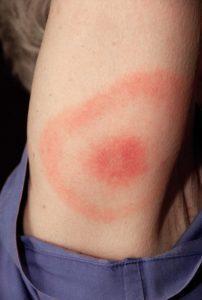
Erythema migrans in Lyme borreliosis. This 2007 photograph depicts the pathognomonic erythematous rash in the pattern of a “bull’s-eye”, which manifested at the site of a tick bite on this Maryland woman’s posterior right upper arm, who’d subsequently contracted Lyme disease. (Source: CDC Public Health Image Library, Photo Credit: James Gathany)
Lyme disease is an infectious disease caused by Borrelia burgdorferi (Bb). Infection occurs through the bite of Borrelia sp.-infected ticks and is one of the most prevalent tick-borne diseases in Asia, Europe and North America. In humans host immune responses are not sufficient to clear established Borrelia sp.-infection and clearance of infection requires antibiotic treatment.
Studies in humans have shown that Borrelia sp.-infection induces B cell and antibody responses, which protect against infection in experimental murine models. However, primary Bb-infection murine models has demonstrated that Bb infection preferentially induces short lived B cell responses over long-lived plasma and memory B cells. This B cell dysregulation is hypothesised to facilitate persistence of Bb infection over clearance. Blum and colleagues, aimed to determine if a similar phenomenon occurs in humans, by correlating variable B cell responses with outcomes of treated Bb-infection in humans.
Blum et al., compared immune responses from healthy Bb-uninfected individuals and antibiotic (doxycycline) treated Bb-infected individuals, of which some individuals returned to health where as others had persistent symptoms even after completion of antibiotic treatment. Untreated Bb-infection was associated with high levels of plasmablasts compared to controls, and significantly decreased to similar levels as controls upon treatment. Interestingly, they observed lower levels of plasmablasts prior to antibiotic treatment in individuals who had persistent symptoms following antibiotic treatment compared to individuals to who returned to health. This observation was accompanied with increased clonal expansion in individuals who returned to health compared to individuals with persistent infection.
In summary, this study identified plasmablasts as key cell population that correlates with resolution of Bb-infection and lyme disease. The study stressed the need for future studies to characterise this population and identify the role it plays in Bb-infection pathogenesis. Additionally, it showed the importance of robust B cell responses in recovery even in the presence of antibiotic treatment. Highlighting the need for future studies to investigate whether prophylaxis with Bb-specific monoclonal antibodies reduces the likelihood of post-treatment Lyme disease syndrome following antibiotic treatment.
Journal Article: Blum et al., 2018. Robust B Cell Responses Predict Rapid Resolution of Lyme Disease. Frontiers in Immunology
Article by Cheleka AM Mpande










